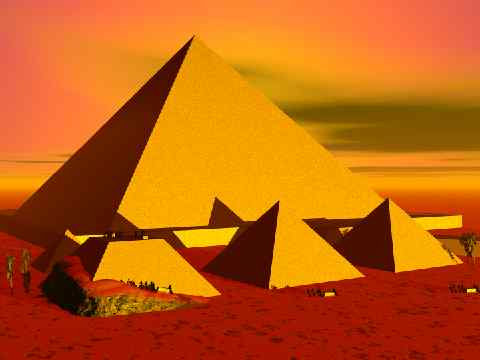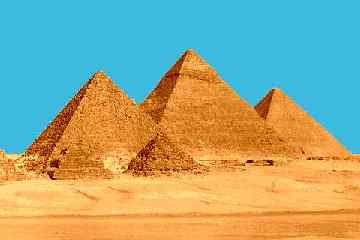




(1) The Pyramids of Egypt, built at Giza during the 4th Dynasty (circa 2680-c.2544 BC) are the oldest of the seven wonders and the only ones remaining intact today. They were built between 2650 and 2500 BC. The temple of Artemis, they are the only one of the seven ancient wonders still standing.
It is 756 feet long on each side, 450 high and is composed of 2,300,000 blocks of stone. Despite the makers' limited surveying tools no side is more than 8 inches different in length than another, and the whole structure is perfect.
Some of the earliest history of the Pyramid comes from a Greek traveler named Herodotus of Halicanassus. He visited Egypt around 450 BC. Herodotus was told by his Egyptian guides that it took twenty-years for a force of 100,000 oppressed slaves to build the pyramid. Stones were lifted into position by the use of immense machines. The purpose of the structure, according to Herodotus's sources, was as a tomb for the Pharaoh Khufu (whom the Greeks referred to as Cheops).
Most of what Herodotus tells us is probably false. Scientists have calculated that fewer men and less years were needed than Herodotus suggests. It also seems unlikely that slaves or complicated machines were needed for the pyramid construction. By the time he visited the site the great pyramid was already 20 centuries old, and much of the truth about it was shrouded in the mists of history.
Certainly the idea that it was a tomb for a Pharaoh, though, seems in line with Egyptian practices. For many centuries before and after the construction of the Great Pyramid the Egyptians had interned their dead Pharaoh-Kings, whom they believed to be living Gods, in intricate tombs. Some were above ground structures, like the pyramid, others were cut in the rock below mountains.
Even in ancient times thieves, breaking into the sacred burial places, were a major problem and Egyptian architects became adept at designing passageways, creating secret, hidden rooms and making decoy chambers. No matter how clever the designers became, though, robbers seemed to be smarter and with almost no exceptions each of the great tombs of the Egyptian Kings were plundered.
Working their way down
the passage they soon found themselves deep in the natural stone below
the pyramid. The corridor stopped descending and went horizontal for about
50 feet, then ended in a blank wall. A pit extended downward from there
for about 30 feet, but it was empty.
Some have suggested
that the pyramid was never meant as a tomb, but as an astronomical observatory.
The Roman author Proclus, in fact, states that before the pyramid was completed
it did serve in this function. We can't put two much weight on Proclus
words, though, remembering that when he advanced his theory the pyramid
was already over 2000 years old.
Many strange, and some silly, theories have arisen over the years to explain the pyramid and it's passageways. Most archaeologists, though, accept the theory that the great pyramid was just the largest of a tradition of tombs used for the Pharaohs of Egypt.
Nobody knows.what happened to Khufu's mummy and treasure? no other chambers or passageways have been found. The last wonder of the ancient world, rests Khufu and his sacred gold.